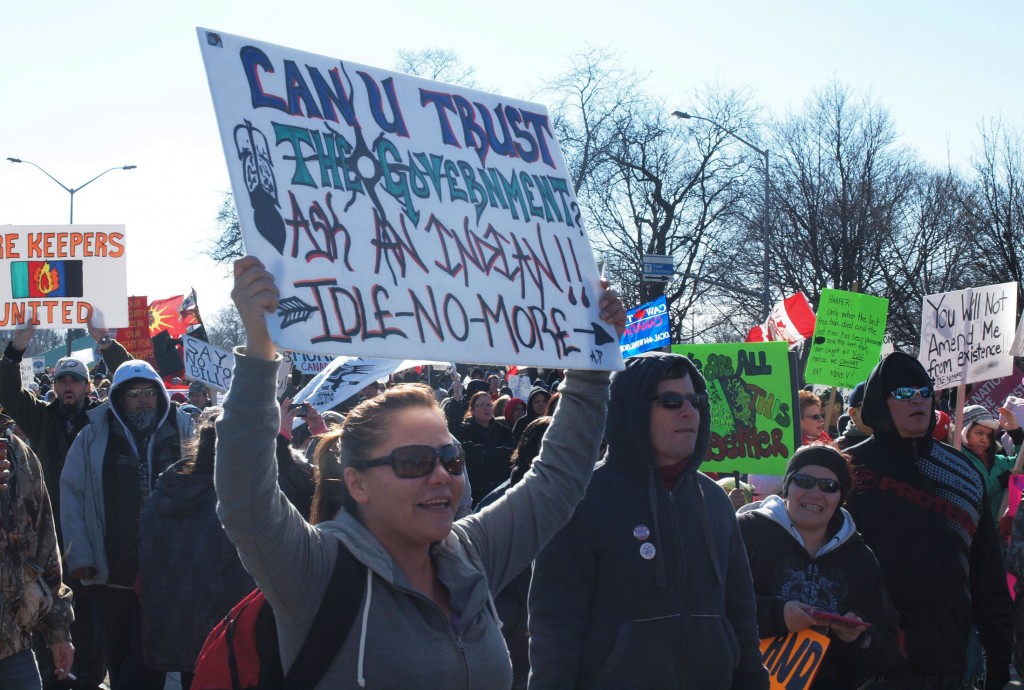Canadians learning more about Idle No More movement

by James Zimmerman
A new poll suggests Canadians remain unsure about ongoing aboriginal efforts to improve the relationship between First Nations and the rest of Canada.
The latest Harris-Decima telephone survey found that 40 per cent of participants said they are both familiar with and sympathetic towards the goals of the Idle No More movement that originated about two months ago.
In October four women in Saskatchewan began exchanging emails about Bill C-45, also known as the Jobs and Growth Act, 2012, which had been newly introduced in Ottawa. Jessica Gordon, Sheelah McLean, Sylvia McAdams and Nina Wilsonfeld were concerned the bill would erode indigenous rights.
They decided to organize an event in Saskatoon for Nov. 10. To help spread the word they turned to Facebook and other social media. They chose to call the page “Idle No More” as a motivational slogan.
A series of protests, teach-ins, blockades and flash mobs began in the aftermath of the federal government’s decision to change oversight of waterways through Bill C-45.
Idle No More said these changes allow “for easier opening of treaty lands and territory.”
Their mission statement reads, “Idle No More calls on all people to join in a revolution which honours and fulfills Indigenous sovereignty which protects the land and water.”
Using social media, the movement has since expanded into a call for ongoing mobilization of First Nations to educate themselves and others about the need for self-governance and environmental sustainability.
However, the popularly of the social media campaign is starting to turn downward. At its highest point, tweets surrounding the movement came from approximately 17,000 different sources. Recently those numbers have dropped to around 5,600. It is unclear if social media has failed to educate people about the cause at hand, said digital public affairs strategist Mark Blevis, who compiled the data.
“I think it was largely a tool for organizing and getting information out in terms of when events were happening, sharing status updates about events. I think that a movement like Idle No More has to work harder to figure out how to communicate their concerns to the public,” said Blevis.
Almost two-thirds of participants who said they were aware of the movement’s goals expressed sympathy for it, with Atlantic Canadians and British Columbians most likely to be supportive.
“This suggests to me that if Idle No More can continue to raise their profile and understanding of what they stand for, their influence can only grow,” said Harris-Decima chairman Allan Gregg.
Online Idle No More activity reached a peak during the Jan. 11 meeting between First Nations chiefs and Prime Minister Stephen Harper, with another bump of approximately 12,000 sources during a followup day of action five days later. Since then, engagement has steadily been declining, according to Blevis.
“There’s a lot of production value that has to go into content and messaging these days in order to get people’s attention,” Blevis said. “If you can’t condense your messages into their essence, they won’t have a particularly long lifespan on the web.”
The telephone survey of 1,000 people was carried out between Jan. 17 and 20 and has a margin of error of plus or minus 3.1 per cent, 19 times out of 20.
Those coming together under the Idle No More movement separate themselves from official First Nations leadership such as the Assembly of First Nations. Other chiefs have tried to capitalize on the publicity of the movement to force new talks with Prime Minister Steven Harper and the federal government.
Attention has been focused on Theresa Spence, chief of the Attawapiskat First Nation in northern Ontario, who concluded a six-week hunger strike Jan. 24. The goal of Spence’s protest was to gain a meeting with Harper and Gov. Gen. David Johnston to discuss how to improve living conditions on native reserves.
Substandard living conditions in Attawapiskat attracted widespread media coverage after Spence declared a state of emergency in late 2011 due to a housing crisis in the community.
Spence soon became the public face of the Idle No More movement, even though the two were never formally linked.
AFN National Chief Shawn Atleo has publicly expressed support for Idle No More.
“Through the ‘Idle No More’ movement, we have seen a tremendous outpouring of energy, pride and determination by our peoples in recent weeks,” Atleo said in a Jan. 3 media release. “This level of citizen and community engagement is absolutely essential to achieve the change we all want.”
Harper said he believes that all parties involved are expressing their rights peacefully and will continue to do so with little threat of a new Occupy movement.
“People have the right in our country to demonstrate and express their points of view peacefully as long as they obey the law, but I think the Canadian population expects everyone will obey the law in holding such protests,” he said at a press conference on Jan. 18 in Oakville, Ont.
On Jan. 24, in exchange for Spence agreeing to end her protest, aboriginal leaders and opposition politicians signed a 13-point declaration setting out how they intend to move the First Nations cause forward.
Idle No More supporters are planning to keep their cause alive as well with a day of action planned for Jan. 28 when federal MPs return to the House of Commons after their Christmas break.



